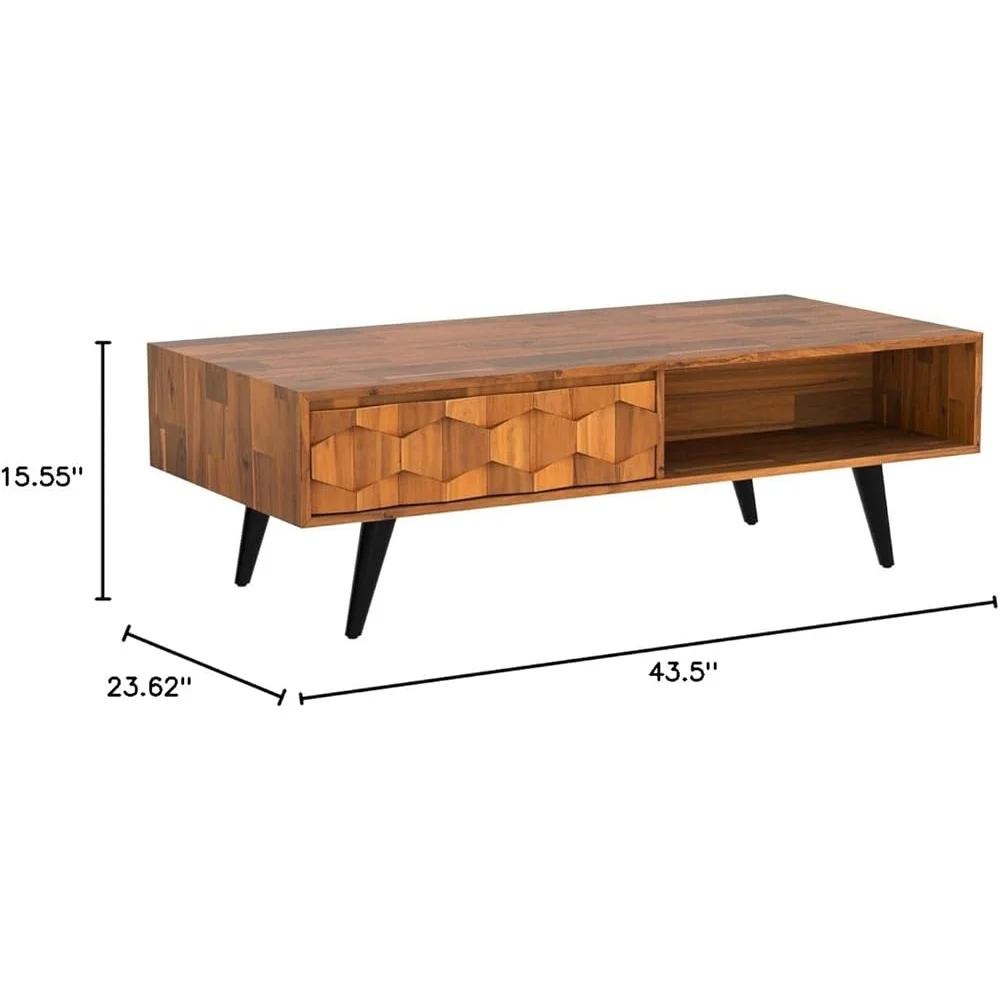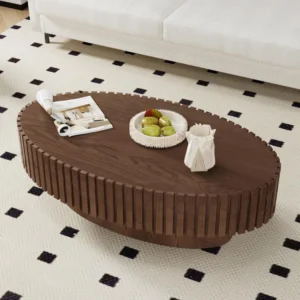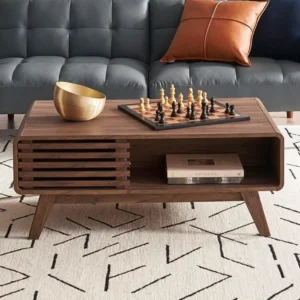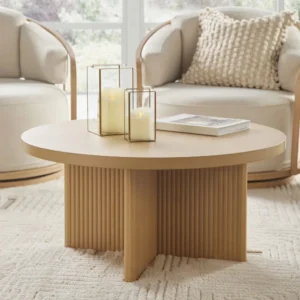Understanding the Fundamentals of Wood Types for Coffee Tables
When shopping for a coffee table, one of the most fundamental decisions you’ll face is choosing between hardwood and softwood. This choice affects not just how your table looks, but how it performs over years of daily use and how it complements your living space.
Contrary to what their names suggest, the distinction between hardwood and softwood isn’t actually about their physical hardness. Rather, it’s a botanical classification:
- Hardwoods come from deciduous trees (those that lose their leaves seasonally) like oak, maple, and walnut
- Softwoods come from coniferous trees (evergreens with needles and cones) like pine, cedar, and fir
Interestingly, some “softwoods” can actually be harder than certain “hardwoods.” For example, yew (a softwood) is considerably harder than balsa (a hardwood). Understanding these distinctions helps you look beyond labels to the actual properties that will matter in your home.
The type of wood in your coffee table affects everything from its weight and durability to how it ages and the care it requires. Intelligent black mid-century coffee tables often showcase these material differences through their thoughtful designs, highlighting the inherent qualities of the wood chosen.
By understanding these fundamental differences, you’ll be better equipped to select a coffee table that meets both your aesthetic preferences and practical needs.
Properties That Matter: Hardwood Coffee Tables
Hardwood coffee tables possess distinctive characteristics that explain their reputation for quality and longevity. Their cellular structure is complex and dense, giving these woods remarkable strength and stability. This density translates directly to furniture that stands up to daily use with exceptional resilience.
Key Features of Hardwood Coffee Tables:
Hardwoods typically grow slowly – sometimes taking decades to mature – which creates a tight grain pattern with closely packed fibers. This slow growth contributes to their higher density and explains why they tend to be heavier than softwood alternatives. A hardwood coffee table will generally feel substantial and solid, with a weightiness that signals quality.
The complex cellular structure of hardwoods provides natural resistance to:
– Scratching and surface damage
– Denting from impact
– Wear patterns from regular use
– Moisture damage (to varying degrees)
This resistance doesn’t mean hardwoods are indestructible, but they typically withstand the rigors of daily life much better than their softwood counterparts. The density measurements tell the story: oak can be 2-3 times denser than pine, translating directly to improved durability.
The porous structure visible in hardwood grain not only contributes to strength but also creates the distinctive character and visual interest that make each piece unique. Mid-century modern solid wood coffee tables showcase these qualities beautifully, with designs that highlight the natural beauty and durability of premium hardwoods.
Properties That Matter: Softwood Coffee Tables
Softwood coffee tables offer their own set of distinctive qualities that make them appealing options for many homes. Understanding their cellular structure helps explain both their benefits and limitations when crafted into furniture.
Key Characteristics of Softwood Coffee Tables:
Softwoods feature a simpler cellular structure than hardwoods, with a more uniform and less dense composition. This creates wood that is:
– Significantly lighter in weight
– More easily worked and shaped
– Generally more affordable
– Often featuring straight, consistent grain patterns
One common misconception is that softwood coffee tables are automatically flimsy or short-lived. While they typically don’t match hardwoods for pure durability, many softwood tables are engineered and finished to provide excellent service. Pine coffee tables, when properly constructed and cared for, can remain beautiful and functional for many years.
A notable advantage of softwoods is their sustainability profile. These trees grow much faster than hardwoods – sometimes 10-20 times quicker – making them a more rapidly renewable resource. This faster growth cycle contributes to their lower cost and reduced environmental impact.
The natural resin content in many softwoods (especially pine and cedar) provides some inherent resistance to moisture and insects, though not typically to the degree found in most hardwoods. Understanding these properties helps set appropriate expectations for how your coffee table will perform over time. For a deeper exploration of wood types and their characteristics, our ultimate guide to solid wood coffee tables provides comprehensive information.
Aesthetic Comparison: Visual Appeal and Design Versatility
When selecting a coffee table, the visual properties of different wood types can dramatically impact how the piece fits within your space. Hardwoods and softwoods offer distinct aesthetic qualities that lend themselves to different design styles.
Hardwood Visual Characteristics:
- Rich, varied grain patterns that create visual depth and character
- Wide color spectrum ranging from the pale tones of maple to the deep chocolate hues of walnut
- Excellent stain reception allowing for versatile finishing options
- Beautiful aging process that often deepens colors and enhances grain over decades
- Subtle luster that develops with proper care and maintenance
Hardwoods like walnut display dramatic grain variations that become conversation pieces in contemporary settings. Cherry wood starts with a lighter appearance but develops a coveted deep amber patina over years of exposure to light and air. Oak’s pronounced grain creates a distinctive look that works wonderfully in both traditional and modern contexts.
Softwood Visual Characteristics:
- More uniform appearance with consistent grain patterns
- Prominent knots and natural irregularities that add rustic charm
- Typically lighter color palette with yellow and pale brown tones
- More visible growth rings due to faster growing seasons
- Casual, relaxed aesthetic well-suited to certain design styles
Pine, the most common softwood for coffee tables, often features distinctive knots that become decorative elements in country, coastal, or casual interiors. Cedar offers reddish tones with aromatic qualities, while fir provides a straight grain pattern ideal for simple, clean designs.
Both wood types offer unique design possibilities. The specific aesthetic qualities of different woods influence how they complement various black mid-century modern coffee table styles, allowing for customized looks that enhance your overall interior design.
Durability and Longevity: Which Performs Better Over Time?
The longevity of your coffee table represents a significant aspect of its overall value. When comparing hardwood and softwood options, several durability factors come into play that directly affect performance over time.
Hardwood Durability Factors:
- Superior resistance to daily wear through higher density composition
- Excellent scratch resistance with higher Janka hardness ratings (measuring wood’s resistance to denting)
- Better stability with less expansion and contraction due to humidity changes
- Longer overall lifespan often measured in decades rather than years
- Greater resilience against accidents and impact damage
Most hardwood coffee tables can withstand the challenges of busy households, including the activities of children and pets. Woods like oak, maple, and walnut have Janka hardness ratings 2-3 times higher than common softwoods, translating to better performance against daily threats like dragged objects or dropped items.
Softwood Durability Considerations:
- More susceptible to surface damage requiring more careful use
- Greater vulnerability to dents from impact or heavy objects
- More reactive to humidity changes potentially causing warping over time
- Shorter typical lifespan though still providing years of service with proper care
- Easier to repair when damage does occur
Moisture presents particular challenges for softwoods, which tend to absorb and release humidity more readily than their hardwood counterparts. This can lead to more pronounced movement in the wood over time. However, proper finishes and careful placement away from extreme conditions can significantly extend a softwood table’s life.
For those prioritizing longevity, mid-century modern walnut coffee tables demonstrate the exceptional durability hardwoods can provide, with many pieces becoming heirloom furniture that serves multiple generations.
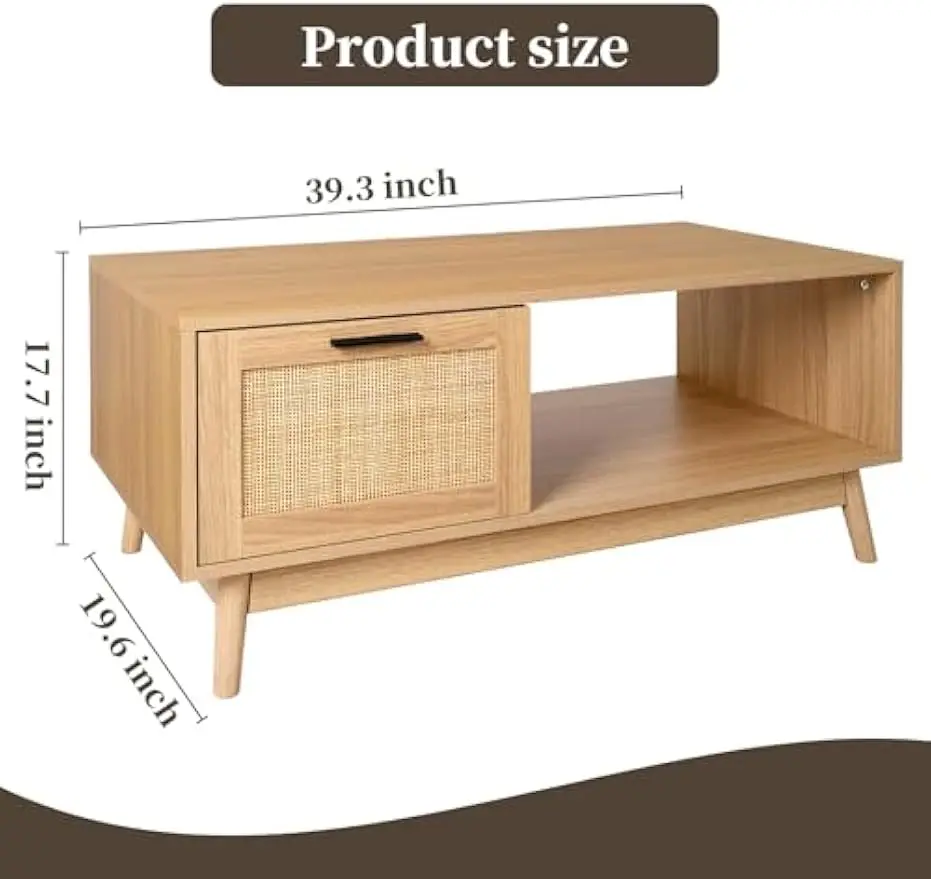
Popular Wood Species for Coffee Tables
Understanding specific wood species helps narrow down your coffee table options to those that best match your needs. Both hardwood and softwood categories include several popular choices, each with distinctive characteristics.
Common Hardwoods for Coffee Tables:
Oak
– Appearance: Prominent grain, light to medium brown
– Durability: Excellent (Janka hardness: 1,290)
– Price Range: Mid-range
– Best For: Traditional, craftsman, and some modern designs; high-traffic areas
Maple
– Appearance: Fine, even grain with pale cream to light reddish-brown color
– Durability: Very high (Janka hardness: 1,450)
– Price Range: Mid to high
– Best For: Contemporary, Scandinavian, and minimalist designs
Walnut
– Appearance: Rich chocolate brown with striking grain patterns
– Durability: Good to excellent (Janka hardness: 1,010)
– Price Range: High
– Best For: Mid-century modern, contemporary, and luxury designs
Cherry
– Appearance: Smooth grain with reddish-brown color that deepens over time
– Durability: Moderate to good (Janka hardness: 950)
– Price Range: Mid to high
– Best For: Traditional, colonial, and transitional styles
Mahogany
– Appearance: Straight grain with reddish-brown tones
– Durability: Good (Janka hardness: 800-900)
– Price Range: High
– Best For: Classic, traditional, and formal settings
Common Softwoods for Coffee Tables:
Pine
– Appearance: Light yellow to honey color with visible knots
– Durability: Moderate (Janka hardness: 380-870 depending on species)
– Price Range: Budget-friendly
– Best For: Country, rustic, farmhouse, and casual interiors
Cedar
– Appearance: Reddish-brown with aromatic properties
– Durability: Moderate (Janka hardness: 350-900 depending on species)
– Price Range: Mid-range
– Best For: Rustic, cabin, and outdoor-inspired designs
Fir
– Appearance: Straight grain with light tan to reddish-brown color
– Durability: Moderate (Janka hardness: 620)
– Price Range: Budget to mid-range
– Best For: Craftsman, mission, and Pacific Northwest styles
For those seeking premium quality and distinctive character, mid-century modern teak coffee tables represent a specialized hardwood option that combines exceptional durability with unique visual appeal.
Maintenance Requirements and Care
The long-term beauty and functionality of your coffee table depend greatly on proper maintenance. Hardwoods and softwoods have different care requirements that should influence your purchasing decision.
Hardwood Coffee Table Care:
Regular Maintenance:
– Dust with soft cloth several times weekly
– Clean with mild wood soap or cleanser monthly
– Apply quality furniture polish quarterly
– Avoid harsh chemical cleaners that can damage finishes
Protection Measures:
– Use coasters under beverages
– Place mats under hot items
– Apply felt pads under decorative objects
– Position away from direct sunlight when possible
Refinishing Requirements:
– Typically needs refinishing every 5-10 years depending on use
– Can usually withstand multiple refinishing processes
– Professional refinishing often yields excellent results
Quick Fixes:
– Minor scratches can be treated with touch-up markers or paste wax
– Oil-based polishes can temporarily hide superficial damage
– Small dents can sometimes be raised with careful steam application
Softwood Coffee Table Care:
Regular Maintenance:
– Dust with soft cloth several times weekly
– Clean with specialized softwood cleanser monthly
– Apply protective wax more frequently (2-4 times annually)
– Inspect regularly for signs of damage
Protection Measures:
– Absolutely essential to use coasters and mats
– Consider glass tops for heavy-use situations
– Avoid sliding objects across the surface
– Keep away from heating vents and direct sunlight
Refinishing Requirements:
– May need refinishing every 3-5 years with normal use
– Easier for DIY refinishing projects
– Takes stains and paints very well for style updates
Quick Fixes:
– Wood fillers work well for minor damage
– Sandable and repairable more easily than hardwoods
– Strategically placed decor can hide problem areas
Understanding how to identify real wood coffee tables helps ensure you’re applying the right care techniques for your specific piece, as maintenance requirements can vary by wood type and finish.
Cost Analysis: Investment vs. Value
Price often becomes a deciding factor when choosing between hardwood and softwood coffee tables. Understanding the true cost implications requires looking beyond just the initial purchase price.
Hardwood Coffee Table Cost Factors:
Initial Price Range:
– Entry-level: $300-$700
– Mid-range: $700-$1,500
– High-end: $1,500-$5,000+
Long-term Value Considerations:
– Typical lifespan of 20-50+ years with proper care
– Cost-per-year analysis often favors hardwoods over time
– Potential heirloom quality that retains or increases value
– Strong resale market for quality pieces
Additional Value Factors:
– Increased durability reduces replacement costs
– Less susceptibility to damage minimizes repair expenses
– Classic appeal tends to transcend short-term trends
– Greater craftsmanship often evident in construction details
Softwood Coffee Table Cost Factors:
Initial Price Range:
– Entry-level: $100-$300
– Mid-range: $300-$700
– High-end: $700-$1,500
Long-term Value Considerations:
– Typical lifespan of 5-15 years with normal use
– Lower initial investment allows for style changes
– Cost-effective for temporary living situations
– Less financial commitment for evolving tastes
Additional Value Factors:
– Affordability permits budget allocation to other furnishings
– Lower replacement cost aligns with more frequent style updates
– DIY-friendly for customization and personalization
– Good option for first homes or apartments
Beyond wood type, other factors affecting price include construction quality, design complexity, brand reputation, and finish types. For those seeking exceptional craftsmanship and timeless appeal, mid-century modern vintage coffee tables represent an investment-grade option with lasting value.
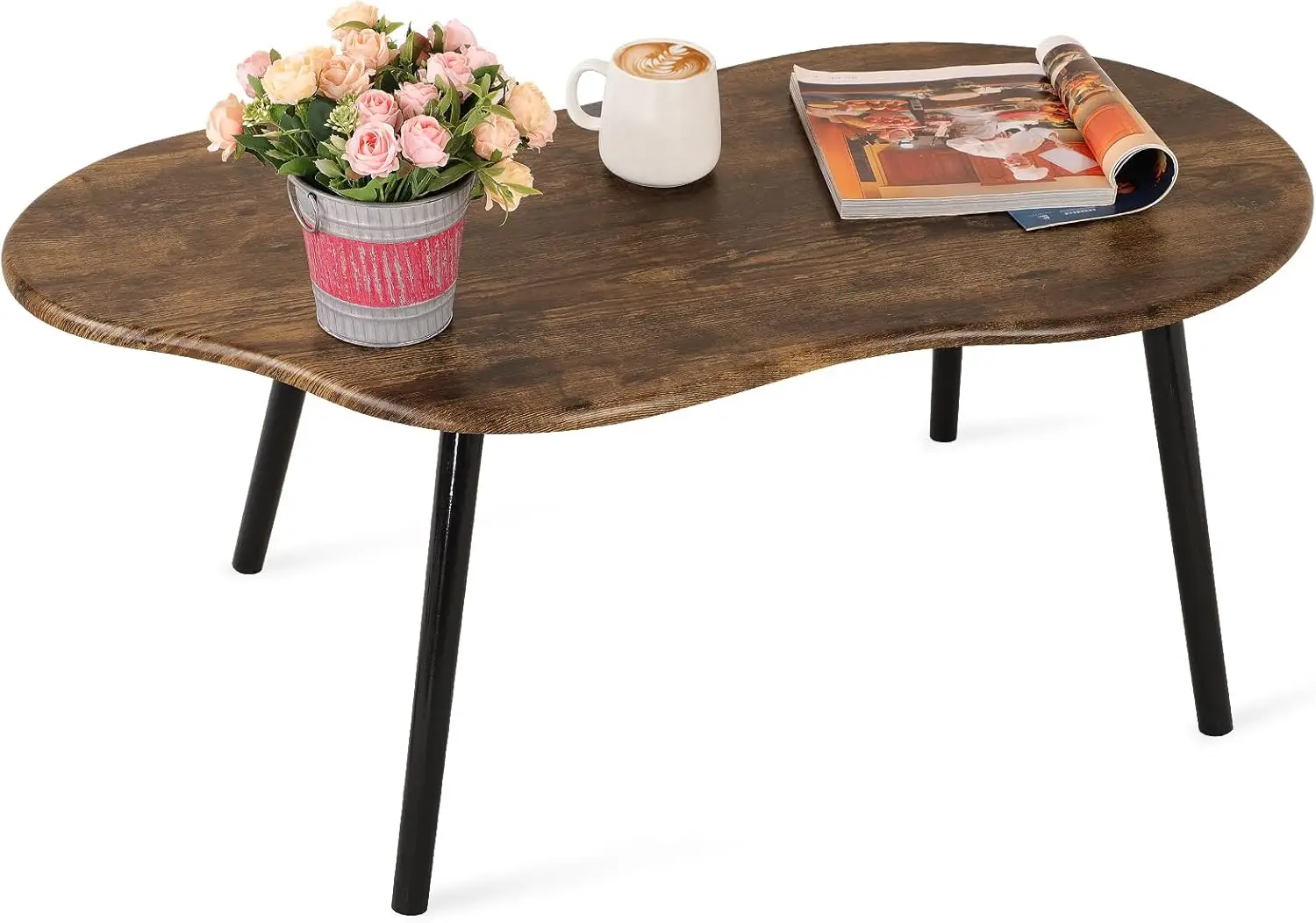
Making the Right Choice: Decision Factors
Selecting between hardwood and softwood coffee tables ultimately comes down to balancing several key considerations against your specific needs and circumstances.
Decision Matrix: Factors to Consider
Household Composition:
– Homes with young children benefit from hardwood’s resistance to damage
– Single-person households may have more flexibility with softwood options
– Pets with claws often necessitate more durable surfaces
Usage Intensity:
– High-traffic living rooms warrant hardwood’s superior durability
– Occasional-use spaces might be well-served by softwood options
– Consider how often items are placed directly on the surface
Design Preferences:
– Traditional, formal, or luxury aesthetics often pair better with hardwoods
– Casual, rustic, or country styles may be enhanced by softwood character
– Some contemporary designs work equally well with either type
Budget Constraints:
– Immediate budget limitations might necessitate softwood
– Long-term budget planning might favor hardwood’s longevity
– Consider the “buy once, cry once” principle for frequently used furniture
Environmental Concerns:
– Sustainably harvested softwoods offer faster renewability
– FSC-certified hardwoods ensure responsible forestry practices
– Local wood sources reduce transportation environmental impact
Ask yourself these questions when making your decision:
1. How long do I plan to keep this coffee table?
2. What level of maintenance am I willing to commit to?
3. Is this a statement piece or a functional item that blends into the background?
4. How does this purchase fit into my overall furniture investment strategy?
5. What are the typical activities that will happen around this table?
Understanding different common wood finishes for coffee tables can also help inform your decision, as certain finishes work better with specific wood types and usage patterns.
Mid-Century Modern Solid Wood Coffee Tables, Mid-Century Modern Teak Coffee Tables
$879.95 Select options This product has multiple variants. The options may be chosen on the product pageMid-Century Modern Danish Coffee Tables, Mid-Century Modern Oval Coffee Tables, Mid-Century Modern Solid Wood Coffee Tables
$390.05 Select options This product has multiple variants. The options may be chosen on the product pageMid-Century Modern Glass Top Coffee Tables, Mid-Century Modern Vintage Coffee Tables, Mid-Century Modern Vintage Side & End Tables
$725.36 Select options This product has multiple variants. The options may be chosen on the product pageMid-Century Modern Oval Coffee Tables, Mid-Century Modern Solid Wood Coffee Tables
$679.56 Select options This product has multiple variants. The options may be chosen on the product pageMid-Century Modern Solid Wood Coffee Tables, Mid-Century Modern Walnut Coffee Tables
$501.53 Select options This product has multiple variants. The options may be chosen on the product pageMid-Century Modern Round Coffee Tables, Mid-Century Modern Solid Wood Coffee Tables
Price range: $522.31 through $559.78 Select options This product has multiple variants. The options may be chosen on the product page
When to Choose Hardwood: Ideal Scenarios
Hardwood coffee tables represent the optimal choice in several specific scenarios where their unique properties provide maximum benefit:
- Family-centered living rooms with children and pets where durability against daily impacts, spills, and activity is essential
- Main entertaining spaces where the coffee table serves as both functional surface and design statement
- Long-term residences where furniture is viewed as a lasting investment rather than a temporary solution
- Design schemes where the table serves as a focal point, with wood grain and character being highlighted features
- Heritage or heirloom considerations where pieces are intended to last for generations
- Formal living environments that benefit from the gravitas and substantial presence of hardwood furniture
- Situations requiring maximum stability for items frequently placed on the surface (heavy books, decor items)
- Open-concept homes where the coffee table is visible from multiple vantage points and needs to maintain its appearance
Hardwood coffee tables particularly shine in spaces designed for both beauty and functionality. The styling options for black mid-century coffee tables demonstrate how these durable pieces can anchor a room while supporting daily life activities.
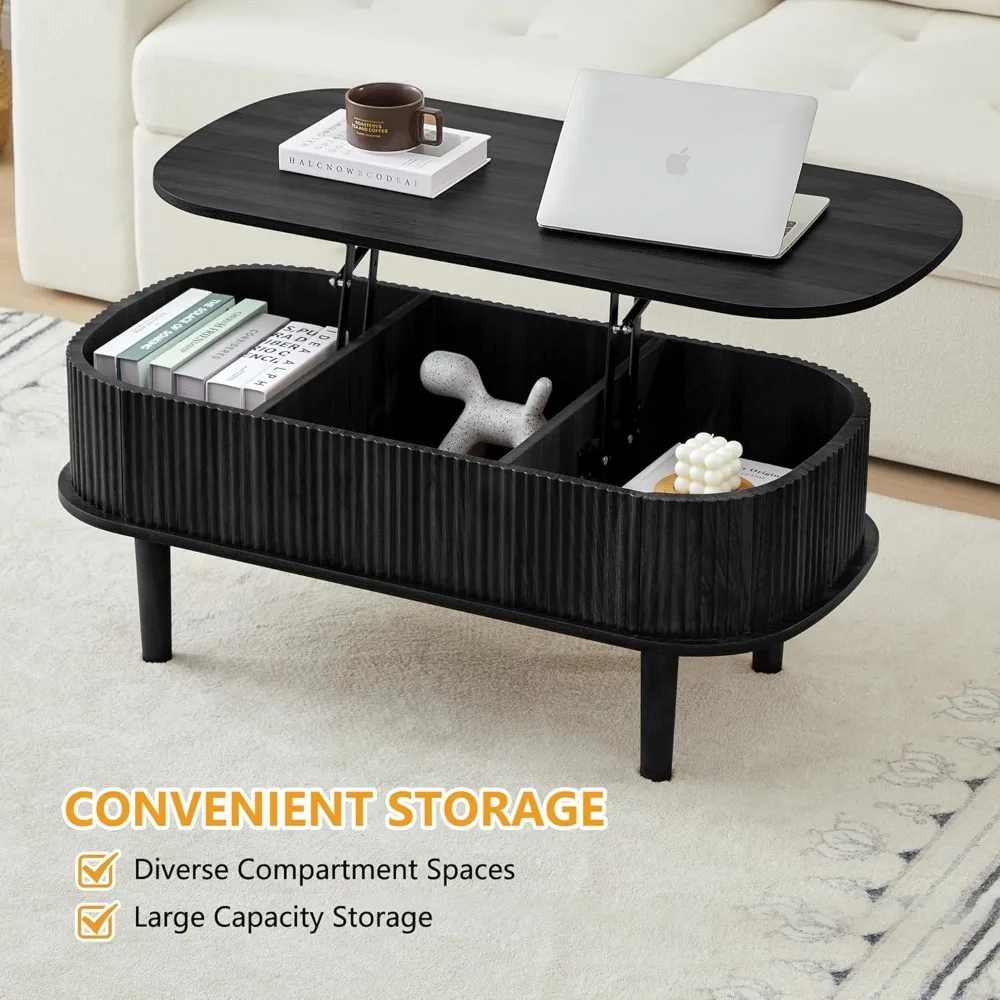
When to Choose Softwood: Ideal Scenarios
Softwood coffee tables present the most practical option in several specific situations where their particular characteristics offer distinct advantages:
- First apartments or starter homes where budget constraints are significant factors
- Spaces undergoing frequent style transitions where furniture isn’t expected to be permanent
- Rental properties where investment in high-end furniture may not be practical
- Rustic, country, or casual interior designs that benefit from softwood’s natural character and knots
- Vacation homes or guest rooms with occasional rather than daily use
- Student housing or temporary living situations where furniture needs are transitional
- Spaces where lightweight furniture is preferred for frequent rearrangement
- DIY enthusiasts who plan to customize, paint, or modify their coffee table over time
- Secondary living spaces like bonus rooms or less formal family areas
The versatility and affordability of softwood tables make them practical choices when flexibility matters more than longevity. For making the most of any coffee table in limited space, explore ideas for maximizing black mid-century coffee tables in smaller rooms.
Frequently Asked Questions About Wood Coffee Tables
Is hardwood always better than softwood for coffee tables?
No, not necessarily. While hardwoods typically offer greater durability and longevity, softwoods provide advantages in terms of cost, weight, and suitability for certain design styles. The “better” choice depends on your specific needs, budget, and aesthetic preferences.
What’s the most scratch-resistant wood for a coffee table?
Hard maple and white oak rank among the most scratch-resistant woods commonly used for coffee tables. Their high density and tight grain structure provide excellent resistance to surface damage from everyday use.
Can softwood coffee tables last as long as hardwood ones?
With exceptional care and in low-traffic environments, well-constructed softwood tables can last many years. However, they typically won’t match the multi-decade or generational lifespan of quality hardwood tables under similar conditions.
How can I tell if a coffee table is made of hardwood or softwood?
Look for distinctive grain patterns (hardwoods typically have more varied grain), weight (hardwoods are generally heavier), and hardness (test by pressing your fingernail gently – it will more easily indent softwood). The presence of knots often, though not always, indicates softwood.
Are there functional differences between hardwood and softwood tables?
Beyond durability, the main functional differences relate to weight and stability. Hardwood tables tend to be heavier and more stable, making them better suited for multi-purpose lift-top coffee tables where mechanism durability matters.

